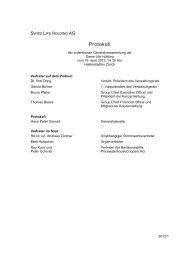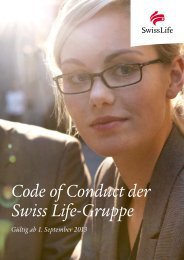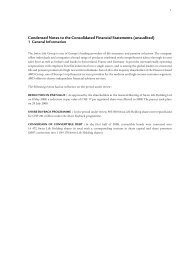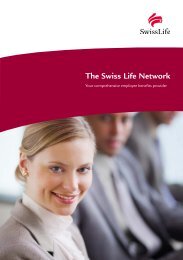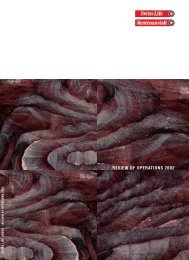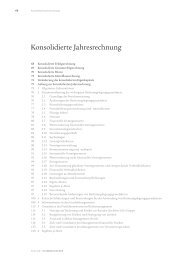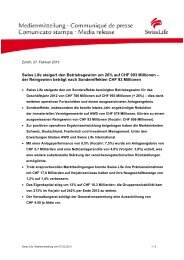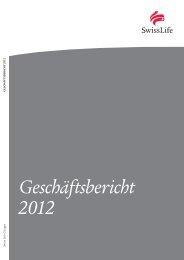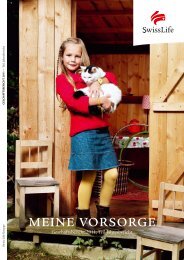Annual Report 2012 - Swiss Life
Annual Report 2012 - Swiss Life
Annual Report 2012 - Swiss Life
Create successful ePaper yourself
Turn your PDF publications into a flip-book with our unique Google optimized e-Paper software.
86 Market Consistent Embedded Value (MCEV)<br />
4 Methodology<br />
4.1 MCEV Components for Covered Business<br />
NET ASSET VALUE (NAV)<br />
The net asset value is the market value of assets allocated to the covered business, which are not backing<br />
liabilities from the covered business.<br />
The net asset value is calculated as the statutory equity capital, adjusted by the unrealised gains or<br />
losses on assets covering the equity capital that are attributable to shareholders after taxes. Depending<br />
on local regulatory restrictions, equalisation reserves are also included in the net asset value. Intangible<br />
assets are not accounted for in the net asset value.<br />
The net asset value is further split between the required capital (RC) and the free surplus (FS).<br />
REQUIRED CAPITAL (RC)<br />
The required capital is the market value of assets, attributed to the covered business – over and above<br />
that required to back liabilities for covered business – whose distribution to shareholders is restricted.<br />
<strong>Swiss</strong> <strong>Life</strong> bases the amount of required capital on 150% of the statutory solvency level according to<br />
Solvency I, except for assumed external reinsurance where an economic approach is used instead.<br />
The amount of required capital disclosed is presented from a shareholder’s perspective and thus is net<br />
of funding sources other than shareholder resources (such as subordinated loans or unallocated<br />
bonus reserves).<br />
FREE SURPLUS (FS)<br />
The free surplus is the market value of assets allocated to, but not required to support, the in-force<br />
covered business at the valuation date. The free surplus is calculated as the difference between the net<br />
asset value and the required capital.<br />
Under the chosen definition of required capital, the free surplus, unlike the required capital, is supposed<br />
to be immediately releasable and hence does not affect the frictional costs of required capital.<br />
VALUE OF IN-FORCE BUSINESS (VIF)<br />
The value of in-force business consists of the following components:<br />
1. Certainty equivalent value (CEV)<br />
2. Time value of financial options and guarantees (TVOG), including the cost of credit risk (see below)<br />
3. Cost of residual non-hedgeable risks (CNHR)<br />
4. Frictional costs of required capital (FC)<br />
In the MCEV Principles, the term present value of future profits (PVFP) is used instead of certainty<br />
equivalent value.<br />
Certainty equivalent value and time value of financial options and guarantees are items that involve<br />
projections encompassing local statutory liabilities and assets in line with:<br />
– local legal and regulatory obligations<br />
– company practice due to commercial and competitive constraints<br />
– local market practice in the calculation of embedded value<br />
<strong>Swiss</strong> <strong>Life</strong> – <strong>Annual</strong> <strong>Report</strong> <strong>2012</strong>



